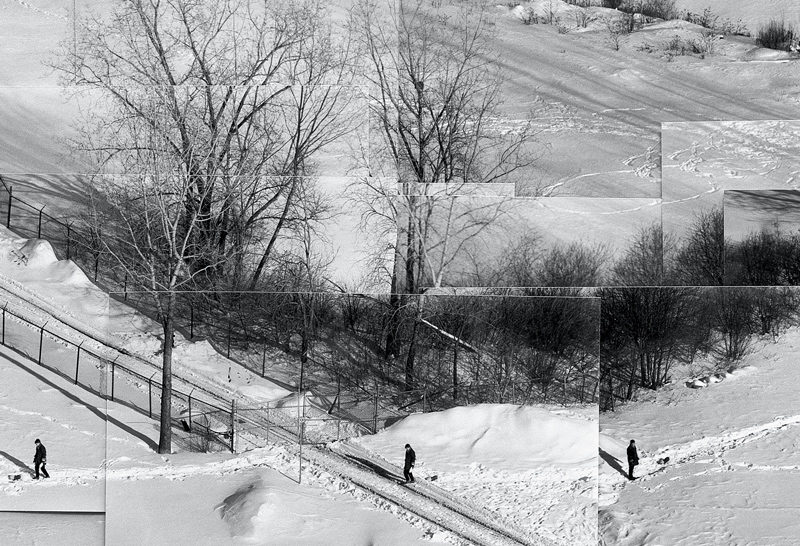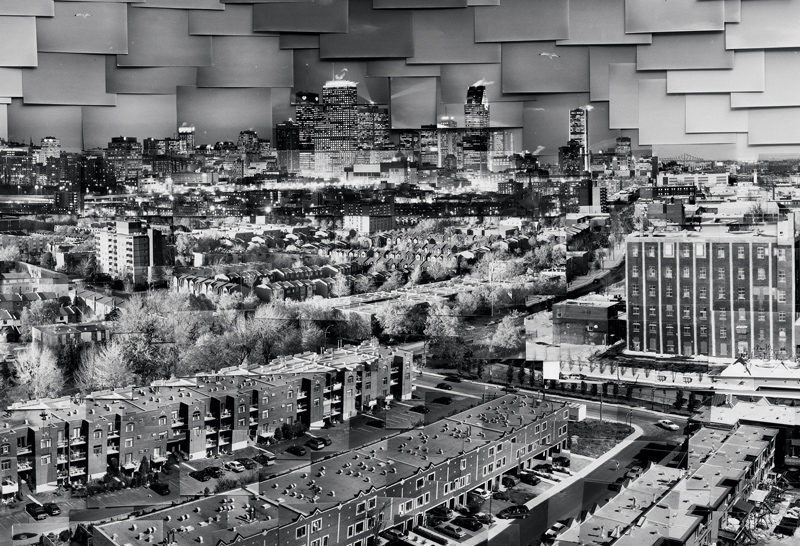[Winter 2012]
André Cornellier
McCord Museum of Canadian History, Montreal
8 April to 16 October, 2011
Two photographic panoramas evocative of nineteenth-century popular entertainment were recently on view at the McCord Museum of Canadian History. The first was a panoramic vista made by the Wm. Notman & Son studio in 1896. The larger of the two, titled The Great Mural, was created by photographer André Cornellier in 1996, exactly a century later. Both show a 360-degree bird’s-eye (or God’s-eye) view of Montreal, as seen from the southwest. Mounted in a large room, on a wall opposite the 1896 panorama, Cornellier’s piece seems, at first glance, to be a prime example of the practice of “rephotography.” Although rephotography has scientific application – in the study of environmental and social change, for example – it has reached popular consciousness through photographers like Mark Klett, whose work has been disseminated in such books as One City/Two Visions: San Francisco Panoramas, 1878 and 1990 (1990) and Third Views, Second Sights, A Rephotographic Survey of the American West (2004). The principal aim of rephotography is to capture, by adopting key visual strategies, the transformations undergone over time by a particular site, object, or person. In the case of site-driven rephotographic projects, much importance is placed on the accurate duplication of the original photograph’s conditions of production: the camera used, the angle from which it was taken, and the specific time of year and day are usually replicated to a T. The choice of the original photograph is also paramount, since the effects of change are most evident when, in fact, certain elements of the scene are unchanged; the full significance of the rephotographic act cannot be grasped if a given site has been altered beyond recognition.
Although, as we are told in the brochure accompanying the McCord exhibition, Cornellier’s Great Mural was prompted by Klett’s photographs, it does not entirely follow the tenets of rephotography. It may be that Cornellier took these tenets as a starting point and ran with them, with the aim of creating something closer to a work of interpretation than of replication. In terms of methodology, Cornellier’s pano-rama differs substantially from Notman’s. The 1896 panorama, the first ever to offer a 360-degree view of the city, is composed of nine horizontal photographs made with an 8’ x 10’ view camera on a single summer day, from atop a power station situated on the corner of William and de la Montagne streets. The beauty and interest of the nineteenth-century images are in part due to the amazing level of detail provided by the large-format negatives; it is all too easy, when looking at these prints up close, to start believing in the fallacy of infinite photographic detail, made famous by Antonioni’s 1966 film Blow-Up. Cornellier’s piece was produced with a hand-held Leica over the course of a year, in different seasons and at different moments of the day (including the evening), from the roof of an industrial building on Dominion Street, near Notre-Dame. The resulting work combines 1,300 prints, selected from an astounding 5,000 negatives. Measuring 3.7 metres high and 18.3 metres wide, The Great Mural is shaped to loosely resemble a pair of lips – a reference to Man Ray’s 1934 painting À l’heure de l’observatoire – Les amoureux, which depicts a female mouth floating above a Parisian cityscape. Cornellier’s decision to represent Montreal through a collage of 1,300 prints contrib-utes to the monumentality of the work, yet it also makes it almost impossible to grasp as a whole. It is as though it can be experienced only at close range – as though each of the 1,300 images needs to be investigated as a single unit. One might suggest that the individual prints that make up The Great Mural act as symbols of the minutiae of everyday life in the city. Without being equally revelatory (some show empty expanses of sky, while others show pedes-trians going about their business), each print comes to stand in for the multitude of largely insignificant occurrences, lives, and places that, combined, create a com-plete yet fractured picture of the urban experience. Rather than replicate with accuracy the Notman panorama’s comprehensive and precise depiction of Montreal as viewed by an all-seeing and all-knowing God (God being in the detail), Cornellier has created a vision of the city that emphasizes the fluid, lived moment. Instead of merely capturing change, Cornellier’s rephotographic act embodies it. Here is an instance of rephotography that takes change itself as one of its formative principles.
Zoë Tousignant is a Ph.D. student in art history at Concordia University. She holds a master’s degree in museum studies from the University of Leeds. Her doctoral research concerns pho-tographic modernism in Canadian illustrated magazines between 1925 and 1945.


